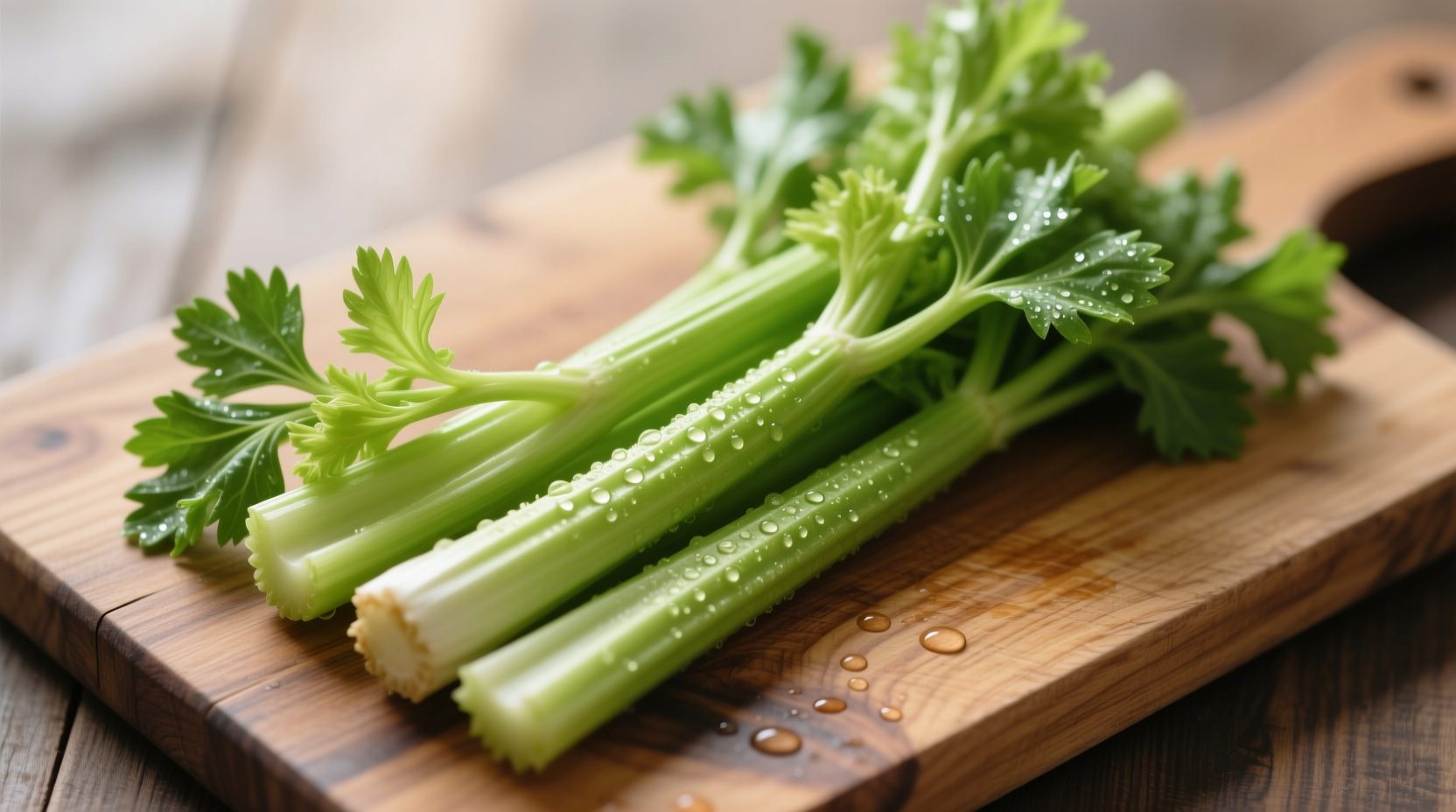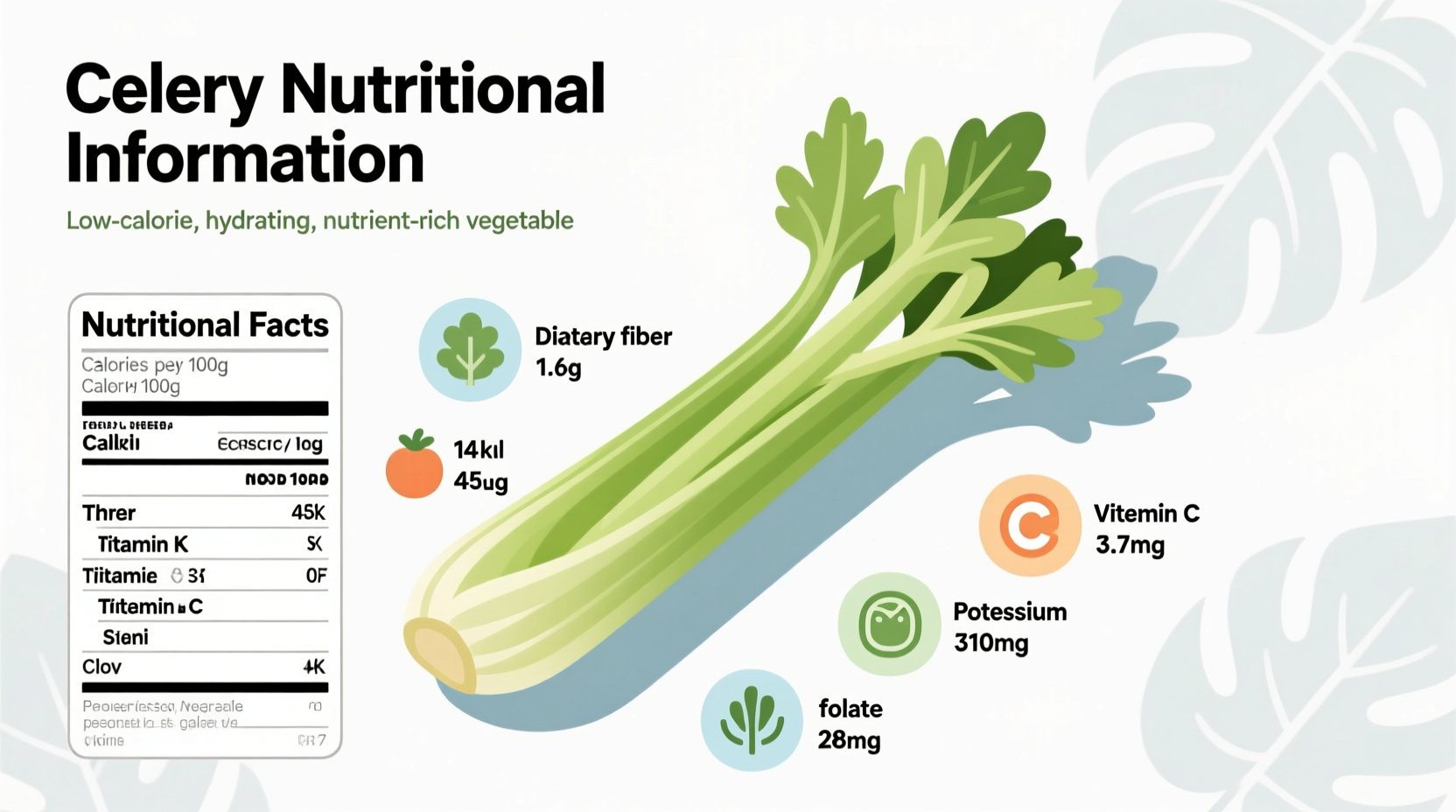Why Celery Deserves a Place in Your Daily Diet
When you reach for that crisp celery stalk, you're choosing one of nature's most hydrating vegetables with surprising nutritional advantages. Unlike many diet foods that sacrifice nutrition for low calories, celery offers meaningful micronutrients while contributing almost no calories to your daily intake. Let's examine exactly what makes this humble vegetable worth reconsidering beyond just a garnish.
Celery's Complete Nutritional Profile
Understanding celery's nutritional composition requires looking beyond just calorie count. The USDA FoodData Central database provides the most current, scientifically verified nutritional information for raw celery. Here's what a standard serving delivers:
| Nutrient | Amount per 100g | Daily Value % |
|---|---|---|
| Calories | 16 kcal | 1% |
| Total Fat | 0.2g | 0% |
| Sodium | 80mg | 3% |
| Total Carbohydrate | 3g | 1% |
| Dietary Fiber | 1.6g | 6% |
| Sugar | 1.3g | - |
| Protein | 0.7g | 1% |
| Vitamin K | 29.6μg | 25% |
| Vitamin A | 22μg | 2% |
| Potassium | 260mg | 6% |
This nutritional breakdown comes directly from the USDA FoodData Central, the official U.S. government database for food composition. The data reflects raw celery, as cooking methods can alter nutrient availability.

Science-Backed Health Benefits of Celery
Celery's nutritional value extends beyond basic vitamins and minerals. Research published in the journal Phytotherapy Research identifies over 16 distinct bioactive compounds in celery, including:
- Apigenin - A flavonoid with demonstrated anti-inflammatory properties
- Luteolin - An antioxidant that may support cognitive function
- Phthalides - Compounds that may help regulate blood pressure
A 2020 review in Nutrients examined celery's potential cardiovascular benefits, noting that regular consumption correlates with modest reductions in blood pressure among pre-hypertensive individuals. While celery shouldn't replace medication, it can be a valuable component of a heart-healthy diet.
Celery Compared to Common Vegetables
Understanding where celery stands nutritionally requires comparison with other vegetables. This comparison table shows how celery stacks up against similar low-calorie options:
| Vegetable (100g) | Calories | Fiber (g) | Vitamin K (μg) | Hydration Level |
|---|---|---|---|---|
| Celery | 16 | 1.6 | 29.6 | 95% |
| Cucumber | 15 | 0.5 | 16.4 | 96% |
| Lettuce | 15 | 1.3 | 126 | 95% |
| Zucchini | 17 | 1.0 | 4.3 | 94% |
Source: USDA FoodData Central. This comparison reveals celery's unique position—it offers more fiber than cucumber while providing significantly more vitamin K than zucchini. Its moderate fiber content combined with high water content creates a satisfying crunch that supports healthy digestion without excessive calories.
Maximizing Celery's Nutritional Benefits
To get the most from celery's nutritional profile, consider these evidence-based preparation tips:
Preserve the Leaves
Most people discard celery leaves, but they contain significantly higher concentrations of nutrients than the stalks. Research from the University of Illinois shows celery leaves contain up to 300% more vitamin C and 50% more calcium than the stalks. Chop and use them as you would parsley in salads, soups, or as a garnish.
Pair with Healthy Fats
The fat-soluble vitamins in celery (like vitamin K) absorb better when consumed with healthy fats. Try celery sticks with almond butter or add chopped celery to avocado salads to maximize nutrient absorption.
Minimal Processing
Unlike some vegetables that benefit from cooking, celery's delicate antioxidants degrade with heat. A study in the Journal of Agricultural and Food Chemistry found that boiling celery for 10 minutes reduced its antioxidant capacity by 25%. For maximum nutritional benefit, enjoy celery raw or lightly steamed.
When Celery Might Not Be Your Best Choice
While celery offers numerous benefits, certain situations warrant consideration:
- For individuals on blood thinners: Celery's vitamin K content (29.6μg per 100g) requires consistent intake if you're taking medications like warfarin. Sudden increases or decreases can affect medication efficacy.
- Organic vs. conventional: The Environmental Working Group consistently lists celery among vegetables with higher pesticide residues. If buying conventional, thorough washing is essential.
- Limited protein contribution: With only 0.7g protein per 100g, celery shouldn't be relied upon as a protein source, though it makes an excellent vehicle for protein-rich dips.
Practical Ways to Incorporate More Celery
Move beyond basic snacks with these nutritionist-approved strategies:
- Replace salt: Use finely diced celery in soups and stews for natural flavor enhancement without added sodium
- Boost hydration: Add chopped celery to water or smoothies for subtle flavor and electrolytes
- Enhance salads: Combine celery with apples, walnuts, and Greek yogurt for a crunchy, nutrient-dense side
- Make vegetable broth: Save celery ends and leaves for homemade broth rich in minerals
Conclusion: The Underrated Nutritional Powerhouse
Celery's reputation as a "negative calorie" food has overshadowed its genuine nutritional contributions. With meaningful amounts of vitamin K, potassium, and unique phytonutrients, this crunchy vegetable deserves recognition as more than just a diet food. When incorporated thoughtfully into your meals—leaves included—celery provides hydration, fiber, and antioxidant benefits that complement a balanced diet. The key is understanding both its strengths and limitations within your overall nutritional strategy.











 浙公网安备
33010002000092号
浙公网安备
33010002000092号 浙B2-20120091-4
浙B2-20120091-4